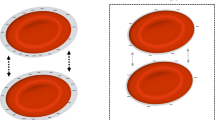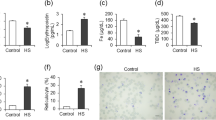Abstract
The aim of the study was to verify the hypothesis if copper could influence the activity of sodium-transporting systems in erythrocyte membrane that could be related to essential hypertension. The examined group of patients consisted of 15 men with hypertension. The control group was 11 healthy male volunteers. The Na+/H+ exchanger (NHE) activity in erythrocytes was determined according to Orlov et al. The activity of transporting systems (ATP-Na+/K+; co-Na+/K+/Cl−; ex-Na+/Li+; free Na+ and K+ outflow [Na+, K+-outflow]) was determined according to Garay's method. The concentration of copper in plasma was assessed using atomic absorption spectrometry. The activity of ATP-Na+/K+ (μmol/L red blood cells [RBCs]/h) in hypertensive patients was 2231.5±657.6 vs 1750.5±291 in the control (p<0.05), the activity of co-Na+/K+/Cl− (μmol/L RBCs/h) in hypertensives was 171.3±77.9 vs 150.7±53.9 in the control (NS). Na+-outflow (μmol/L RBCs/h) in hypertensives was 118.3±51.6 vs 113.3±24.4 in the control (NS). The K+-outflow (μmol/L RBCs/h) in hypertensives was 1361.7±545.4 vs 1035.6±188.3 in the control (NS). The activity of ex-Na+/Li+ (μmol/L RBCs/h) in hypertensive patients was 266.1±76.1 vs 204.1±71.6 in the control (p<0.05). NHE activity (mmol/L RBCs/h) in hypertensives was 9.7±2.96 vs 7.7±1.33 in the control (p<0.05). In hypertensive patients, negative correlation was found between the activity of Na+/K+/Cl− co-transport and plasma copper concentration (R s=−0.579, p <0.05) and between the activity of ex-Na+/Li+ and plasma copper concentration (R s=−0.508, p<0.05). Plasma copper concentration significantly influences the activity of sodium transporting systems in erythrocyte membrane. Copper supplementation could be expected to provide therapeutic benefits for hypertensive patients.
Similar content being viewed by others
References
R. Lijnen, Alterations in sodium metabolism as an etiological model for hypertension, Cardiovasc. Drugs Ther. 9, 377–399 (1995).
A. Semplicini, M. Canessa, M. G. Mozzato, et al., Red blood cell Na+/H+ and Li+/Na+ exchange in patients with essential hypertension, Am. J. Hypertens. 2, 903–908 (1989).
P. Delva, C. Pastori, M. Degan, et al., Erythrocyte Na+/H+ exchanger kinetics and Na+/Li+ countertransport activity in essential hypertensive patients, Eur. J. Clin. Invest. 26, 64–70 (1996).
A. Alonso, A. Arrazola, A. Garciandia, N. Esparza, C. Gomez-Alamillo, and C. Diez, Erythrocyte anion exchanger activity and intracellular pH in essential hypertension, Hypertension 22, 348–356 (1993).
J. Bober, K. Kędzierska, E. Kwiatkowska, et al., The erythrocyte sodium-proton exchanger activity in patients with primary hypertension. Pol. Arch. Med. Wewn. 1, 619–624 (2002).
M. Soleimani and G. Singh, Physiologic and molecular aspects of the Na+/H+ exchangers in health and disease processes, J. Invest. Med. 43, 419–430 (1995).
M. Wehling, J. Kasmayar, and K. Theisen, The Na+/H+ exchanger is stimulated and cell volume increased in lymphocytes from patients with essential hypertension, J. Hypertens. 9, 519–524 (1991).
M. Canessa, K. Morgan, R. Goldszer, T. J. Moore, and A. Spalvins, Kinetics abnormalities of the red blood cell sodium-proton exchange in hypertensive patients, Hypertension 17, 340–348 (1991).
O. Giampietro, E. Matteucci, G. Catapano, et al., Microalbuminuria and erythrocyte sodium-hydrogen exchange in essential hypertension. Hypertension 25, 981–985 (1995).
A. de la Sierra, A. Coca, J. C. Pare, M. Sanchez, V. Valls, and A. Urbano-Marquez, Erythrocyte ion fluxes in essential hypertensive patients with left ventricular hypertrophy, Circulation 88, 1628–1633 (1993).
J. Zicha, Red cell ion transport abnormalities in experimental hypertension, Fundam. Clin. Pharmacol. 7, 129–141 (1993).
H. E. Ives, Ion transport defects and hypertension. Where is the link?. Hypertension 14, 590–597 (1989).
M. Avkiran, Protection of the ischaemic myocardium by Na+/H+ exchange inhibitors: potential mechanisms of action, Basic Res. Cardiol. 96, 306–311 (2001).
M. Karmazyn, Role of sodium-hydrogen exchange in cardiac hypertrophy and heart failure: a novel and promising therapeutic target, Basic Res. Cardiol. 96, 325–328 (2001).
E. Matteucci, V. Di Bello, and O. Giampietro, Integrated analysis of erythrocyte Na+/H+ antiport activity and left ventricular nyocardial function in type I insulin-dependent diabetes mellitus, J. Diabetes Complic. 9, 208–211 (1995).
M. Toborek, T. Wasik, M. Drozdz, M. Klin, K. Magner-Wrobel, and E. Kopieczna Grzebieniak, Effect of hemodialysis on lipid peroxidation and antioxidatant system in patients with chronic renal failure, Metabolism 41, 1229–1232 (1992).
M. Cutaia and N. Parks, Oxidant stress decreased Na+/H+ antiport activity in bovine pulmonary artery endothelial cells, Am. J. Physiol. 267, L649-L659 (1994).
Q. Hu, Y. Xia, S. Corda, J-L. Zweier, and R-C. Ziegelstein, Hydrogen peroxidase decreased pHi in human aortic endothelial cells by inhibiting Na+/H+ exchange, Circ. Res. 83, 644–651 (1998).
E. Matteucci and O. Giampietro. Oxidative stress in families of type 1 diabetic patients, Diabet. Care. 24, 167–168 (2001).
A. Y. Bogdanova, L. V. Virkki, G. P. Gusev, and M. Nikinmaa, Copper effects on ion transport across lamprey erythrocyte membrane: Cl(−)/OH(−) exchange induced by cuprous ions, Toxicol. Appl. Pharmacol. 159, 204–131 (1999).
A. Y. Bogdanova, M. Gassman, and M. Nikinmaa, Copper ion redox state is critical for its effects on ion transport pathways and methaemoglobin formation in trout erythrocyte, Chem. Biol. Ineract. 139, 43–59 (2002).
I. Hajjar and T. Kotchen, Regional variations of blood pressure in the United States are associated with regional variations in dietary intakes: the NHANES-III data, J. Nutr. 133, 211–214 (2003).
M. D. Chen and W. H. Sheu, Plasma status of selected minerals in hypertensive men with and without insulin resistance, J. Trace Elements Med. Biol. 14, 228–231 (2001).
C. Russo, O. Olivieri, D. Girelli, et al., Anti-oxidant status and lipid peroxidation in patients with essential hypertension, J. Hypertens. 16, 1267–1271 (1998).
L. M. Klevay, Cardiovascular disease from copper deficiency-a history, J. Nutr. 130(2S Suppl.), 489S-492S (2000).
S. K. Taneja, M. Mahajan, S. Gupta, and K. P. Singh, Assessment of copper and zinc status in hair and urine of young women descendants of NIDDM parents, Biol. Trace Element Res. 62, 255–264 (1998).
O. Jung, S. L. Marklund, H. Geiger, T. Pedrazzini, R. Busse, and R. P. Brandes, Extracellular superoxide dismutase is a major determinant of nitric oxide bioavailability: in vivo and ex vivo evidence from ecSOD-deficient mice, Circ. Res. 93, 622–629 (2003).
C. S. Wilcox, Redox regulation of the afferent arteriole and tubuloglomerular feedback, Acta Physiol. Scand. 179, 217–223 (2003).
S. N. Orlov, I. Y. Postnov, N. I. Pokudin, V. Y. Kukharenko, and Y. V. Postnov, Na+-H+ exchange and other ion-transport systems in erythrocytes of essential hypertensives and spontaneously hypertensive rats: a comparative analysis, J. Hypertens. 7, 781–788 (1989).
R. P. Garay, C. Nazaret, J. Diez, et al., Stimulation of K+ fluxes by diuretic drugs in human red cells, Biochem. Pharmacol. 33, 2013–2020 (1984).
G. Zerbini, A. Maestroni, D. Breviario, R. Mangili, and G. Casari, Alternative splicing of NHE-1 mediates Na−Li countertransport and associates with activity rate, Diabetes 52, 1511–1518 (2003).
L. L. Ng, P. A. Quinn, F. Baker, and S. J. Carr, Red cell Na+/Li+ countertransport and Na+/H+ exchanger isoforms in human proximal tubules, Kidney Int. 58, 229–235 (2000).
G. Zerbini, F. Podesta, G. Meregalli, G. Deferrari, and R. Pontremoli, Fibroblast Na+−Li+ countertransport rate is elevated in essential hypertension, J. Hypertens. 19, 1263–1269 (2001).
A. A. McDonough, P. K. Leong, and L. E. Yang, Mechanisms of pressure natriuresis: how blood pressure regulates renal sodium transport, Ann. NY Acad. Sci. 986, 669–677 (2003).
J. Bober, E. Kwiatkowska, K. Ciechanowski, et al., Do trace elements modify the activity of erythrocyte sodium-proton exchanger in hemodialyzed patients? Biol. Trace Element Res., 104, 107–120 (2005).
D. A. Clopton and P. Saltman, Copper-specific damage in human erythrocytes exposed to oxidative stress, Biol. Trace Element Res. 56, 231–240 (1997).
Author information
Authors and Affiliations
Rights and permissions
About this article
Cite this article
Kędzierska, K., Bober, J., Ciechanowski, K. et al. Copper modifies the activity of sodium-transporting systems in erythrocyte membrane in patients with essential hypertension. Biol Trace Elem Res 107, 21–32 (2005). https://doi.org/10.1385/BTER:107:1:021
Received:
Accepted:
Issue Date:
DOI: https://doi.org/10.1385/BTER:107:1:021




